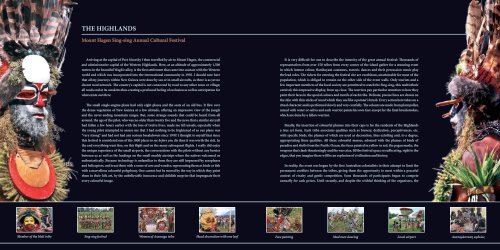PAPUA
Create successful ePaper yourself
Turn your PDF publications into a flip-book with our unique Google optimized e-Paper software.
THE HIGHLANDS<br />
Mount Hagen Sing-sing Annual Cultural Festival<br />
Arriving at the capital of Port Moresby I then travelled by air to Mount Hagen, the commercial<br />
and administrative capital of the Western Highlands. Here, at an altitude of approximately 1,500<br />
metres in the beautiful Waghi valley, is the first settlement that came into contact with the Western<br />
world and which was incorporated into the international community in 1930. I should note here<br />
that all my journeys within New Guinea were done by sea or in small aircrafts, as there is as yet no<br />
decent road network. The country’s capital is not connected by road to any other town or village;<br />
all roads end at its outskirts thus creating a profound feeling of exclusion as well as anticipation for<br />
what exists out there.<br />
The small single-engine plane had only eight places and the seats of an old bus. It flew over<br />
the dense vegetation of New Guinea at a low altitude, offering an impressive view of the jungle<br />
and the never-ending mountain ranges. But, some strange sounds that could be heard from all<br />
around, the age of the pilot, who was no older than twenty five and the news that a similar aircraft<br />
had fallen a few hours earlier with the loss of twelve lives, made me fell unsafe, especially when<br />
the young pilot attempted to assure me that I had nothing to be frightened of as our plane was<br />
“very strong” and had not had any serious breakdowns since 1970! I thought to myself that since<br />
this festival is considered one of the 1000 places to see before you die then it was worth the risk. In<br />
the end everything went fine, on this flight and on the many subsequent flights. I really did enjoy<br />
the unique experience of the small airports, the conversations with the pilots without any barrier<br />
between us as well as the landings on the small muddy airstrips where the natives welcomed us<br />
enthusiastically. Because technology is unfamiliar to them they are still impressed by aeroplanes<br />
and helicopters, and treat them with a sense of awe and wonder, representing them as birds or fish<br />
with a marvellous colourful polyphony. One cannot but be moved by the way in which they paint<br />
them in their folk art, by the unbelievable innocence and childish surprise that impregnate their<br />
every colourful image.<br />
It is very difficult for one to describe the intensity of the great annual festival: Thousands of<br />
representatives from over 150 tribes from every corner of the island gather for a stunning event<br />
in which intense colour, flamboyant costumes, esoteric dances and their percussion music play<br />
the lead roles. The tickets for entering the festival site are exorbitant, unattainable for most of the<br />
population, which is obliged to remain on the other side of the event walls. Only tourists and a<br />
few important members of the local society are permitted to watch the Sing-sing, this multiethnic<br />
carnival, this impressive display, from up close. The warriors pay particular attention to how they<br />
paint their faces in the special colours and motifs of each tribe. Delicate, precise lines are drawn on<br />
the skin with thin sticks of wood which they use like a painter’s brush. Every action here takes on a<br />
ritual character and is performed slowly and very carefully. The colours are made from plant pollen<br />
mixed with water or saliva and each warrior paints his own face except for the final brushstrokes,<br />
which are done by a fellow warrior.<br />
Finally, the insertion of colourful plumes into their caps is for the residents of the Highlands<br />
a true art form. Each tribe associates qualities such as bravery, dedication, perceptiveness, etc.<br />
with specific birds, the plumes of which are used as decoration, thus extolling and, to a degree,<br />
appropriating these qualities. All these colourful masses, adorned with the plumes of birds of<br />
paradise and shells from the Pacific Ocean, the faces painted in yellow or red, the pagan masks, the<br />
weapons that clank threateningly and the war cries, fill the festival space so suffocating, right to the<br />
edges, that you imagine there will be an explosion of civilisation and history.<br />
In reality, the event was begun by the first Australian colonialists in their attempt to limit the<br />
permanent conflicts between the tribes, giving them the opportunity to meet within a peaceful<br />
context of rivalry and gentle competition. Soon thousands of participants began to compete<br />
annually for cash prizes. Until recently, and despite the wishful thinking of the organisers, the<br />
Member of the Huli tribe<br />
Sing-sing festival Women of Asamuga tribe Head decoration with one leaf<br />
Face painting<br />
Mud men dancing<br />
Local airport<br />
Αναπαράσταση κηδείας

















